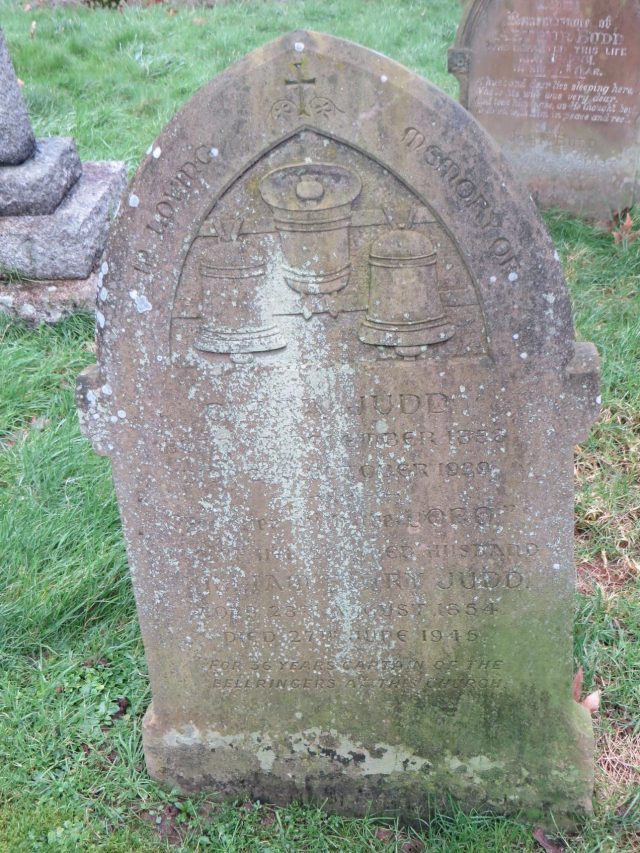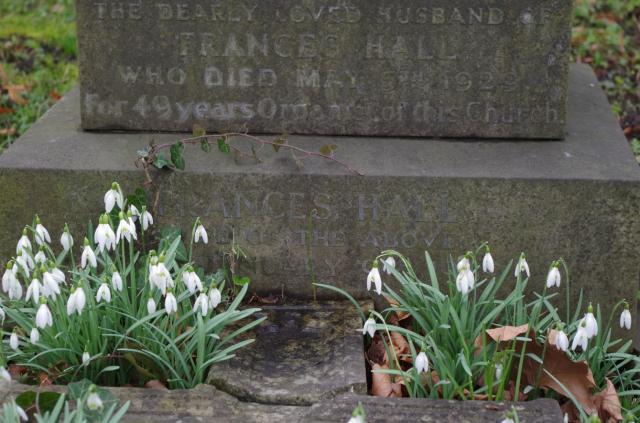
The Church Bell is an unusual and rare symbol to be found in a cemetery or churchyard. So far I have found two examples but I feel sure that there are others out there. This post was inspired by the three bells that I saw on a Mr Judd’s headstone in St Michael’s churchyard, Betchworth, Surrey. It must be an ex-bellringer I thought and sure enough the epitaph stated that Mr Judd was:
‘ for 36 years Captain of the Bellringers at this Church.’
The central bell on the three appeared to be ringing but was it a specific peal? A secret message to other bellringers?

The second one was in Beckenham Cemetery and was dedicated to Henry Robert Taylor but with no further information on it. This time all three bells appeared to be static.


So I contacted The Central Council of Church Bellringers (yes it does exist) to find out if they could shed light on the bells. Firstly, they were very interested in my photos as these are rare memorials and they didn’t know that they existed. One of their members, a retired Captain of Bellringers and historian, was kind enough to reply and said that the Taylor headstone was probably the grave of a bellringer which was close to the door of the bell ringing chamber. He added that the bells depicted were inaccurate for English church bell ringing and thought that it might be a standard pattern designed to fit a pointed headstone.
However, with the Judd headstone in Betchworth he thought that the bells were a much better representation of a church bell hung for ‘change ringing’. Change ringing is an English form of bell ringing and if you want to know more there is a link in the references and further reading section.
I then approached the churchwarden at St Michael’s who informed me that the Judd tombstone was originally dedicated to Clara Judd but eventually William Henry (Bill) was added to the inscription. He also confirmed that Bill is buried close to the door of the church’s bell-tower. In 1910, Canon Sanders paid tribute to his astonishing 36 years as Captain of the Bellringers by saying that
‘…the whole parish owes a debt of gratitude.’
And here he is:

©Betchworth within Living Memory.

©Betchworth within Living Memory
These two headstones and the bellringing references reminded me of the links between church bells, the rituals of the church and death. The most obvious one is ringing the ‘death toll.’ which appears in Shakespeare’s Sonnet 71:
‘No longer mourn for me when I am dead,
Than you should hear the surly, sullen bell,
Give warning to the world that I am fed
From this vile world with vilest worms to dwell.’
There is also the often quoted final lines from John Donne’s 1624 Meditation 17, from Devotions Upon Emergent Occasions:
‘Therefore, send not to know
For whom the bell tolls,I
It tolls for thee’.
Although only the ‘death toll’ is used today, originally there were three tolls that were rung and they denoted different stages of death. I am indebted to the headstonesymbols.co.uk blog for this:
‘There was superstition that evil spirits would gather around a dying person, trying to catch the departing soul. To give the soul a chance of ascending to heaven, church bells were rung at the time of death to frighten away these demonic forces. It was even added to the rules of the early Church of England that:
…when any is passing out of this Life, a Bell shall be Tolled, and the Minister shall not then slack to do his last Duty. And after the Parties Death (if it so fall out) there shall be rung no more than one short Peal, and one other before the Burial, and one other after the Burial.
Church of England Canon law; 1604
The Passing Bell
The first ringing to indicate an impending death was called the “Passing Bell“. This was to alert the priest that he was needed to perform the Last Rights.
The Death Knell
A “Death Knell” was rung immediately after the death. This was a slow solemn peal and each strike or teller identified the sex and age of the deceased. In small communities they would know from this who had passed and who’s souls to pray for.
From the number of strokes being formerly regulated according to circumstances, the hearers might determine the sex and social condition of the dying or dead person. Thus the bell was tolled twice for a woman and thrice for a man. If for a clergyman, as many times as he had orders, and, at the conclusion, a peal on all the bells to distinguish the quality of the person for whom the people are to put up their prayers. In the North of England, are yet rung nine knells for a man, six for a woman, and three for a child.
Old Church Lore by William Andrews
Lych or Corpse Bell
The last bell, the Lych or Corpse bell would be rang at the funeral, and is the only one that survives today.’
The Funeral Toll was also rung as the procession approached the church and was known as ‘ringing home the dead’.
The Dead Bell

However, in Scotland and parts of Northern England, a hand bell was rung which was known as the dead bell. This was used with deaths and funerals until the 19th century. The dead bells were rung for two reasons; to protect the newly deceased from evil spirits and to also seek prayers for the dead person’s soul. These ‘dead bells’ are often carved on monuments and tombstones in Scotland and Northern England. There are two men ringing dead bells on the Bayeux Tapestry at the funeral of Edward the Confessor:

Shared under Wiki Creative Commons
But there are also superstitions and beliefs concerned with church bells particularly during the medieval period. They were thought to have special protective powers to drive away evil spirits for example and were often baptised. After all, most people know of the Houses of Parliament’s world famous Great Bell in its clock house, Big Ben. The Catholic church still has a blessing for new bells in which they’re given the power to protect those who hear them, repel storms and triumph over evil.
There are also several legends concerning bells that have ended up underwater either due to cliff erosion, a reservoir or hidden in lakes. They are reputed to ring from their watery graves at dead of night.
Bells have always been an intrinsic part of church life whether ringing to denote the end of a life or jubilantly pealing at the beginning of a new life in marriage. They have been held in reverence and awe due to their supposedly magical powers. Even today, they sometimes have names and are seen as part of the community. Both the Betchworth and Beckenham headstones record a connection between man and church bell that has lasted for centuries.
©Text and photos Carole Tyrrell unless otherwise stated.
References and further reading:
http://headstonesymbols.co.uk/headstone-meanings-and-symbols/bell-on-headstone/
http://www.solwaypast.co.uk/index.php/structures-in-stone/13-mem/90-st
https://en.wikipedia.org/wiki/Dead_bell
https://en.wikipedia.org/wiki/Death_knell
http://www.sacred-texts.com/etc/fcod/fcod08.htm
https://en.wikipedia.org/wiki/Taphophobia
http://headstonesymbols.co.uk/headstone-meanings-and-symbols/bell-on-headstone/ http://www.famousliteraryworks.com/donne_for_whom_the_bell_tolls.htm










